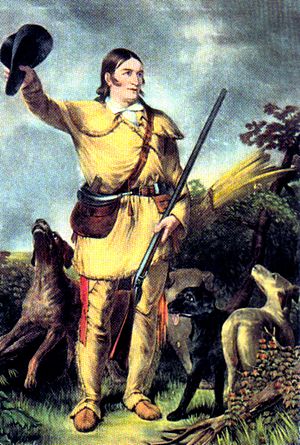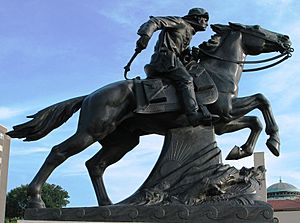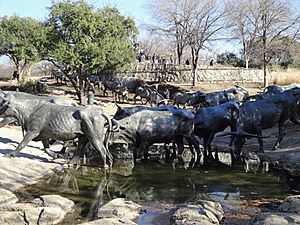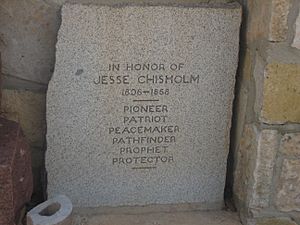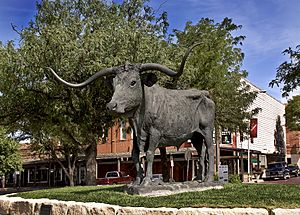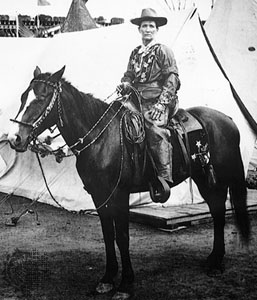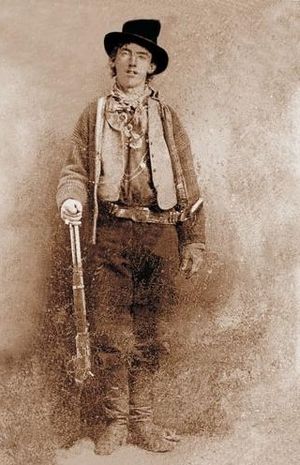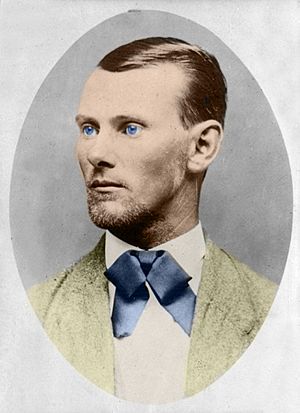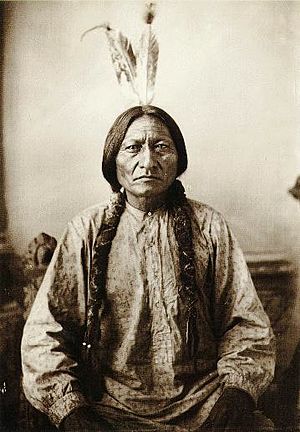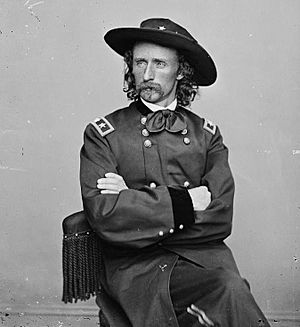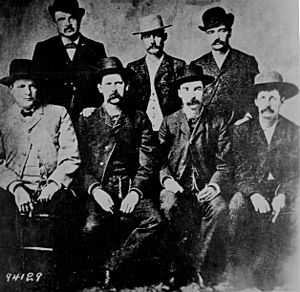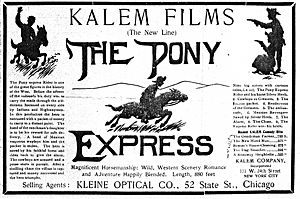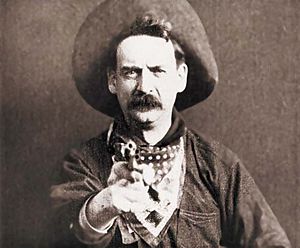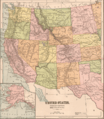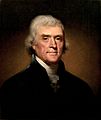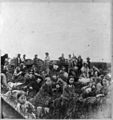American Old West facts for kids
Quick facts for kids 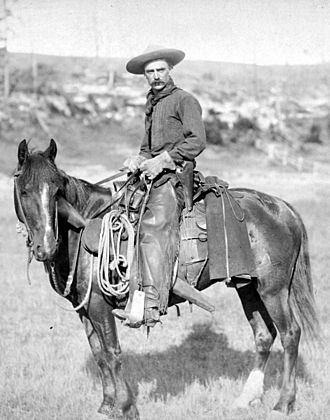
The cowboy, the quintessential symbol of the American frontier, circa 1887
|
|
| Date |
|
|---|---|
| Location | Currently the United States, historically in order of their assimilation:
|
The American Old West is generally considered to be located in western North America, usually the Western United States, and usually during the time period of the late 19th century.
It has played an important role in history and fiction. The terms Old West and Wild West refer to life beyond the settled frontier. It could mean the western states as far back as the time when the thirteen colonies were being established, but it usually meant to mean the late 1800s in the land called the "Frontier Strip."
Contents
- Overview
- Before Colonization
- Early explorers and trappers
- Trails, roads, and routes
- Davy Crockett
- The Gold Rush and Civil War era
- The Wild Wild West
- Dodge City
- Wild Bill and Calamity Jane
- Lincoln County War
- Jesse James
- Western Indian Wars
- Gunfight at the O.K. Corral
- Buffalo Bill Wild West Show
- Fiction and non-fiction
- Western movies
- Interesting facts about the American Old West
- Images for kids
- See also
Overview
Many tales of Old West life focus on things that make good stories. In typical Western fiction, the Old West is a dry landscape populated by many archetypes, including:
- Cowboys and Indians
- Lawmen and various types of outlaws
- Gold miners (usually at their gold mines)
- Trappers
- various other explorers
Conflicts usually happened over water, since land without water is of little value in the dry western states. The series of gold rushes in the Old West led to a rushed migration of workers into the frontier because of the discoveries of gold. In the history of the United States and Canada, several gold rushes took place throughout the later 19th century.
Before Colonization
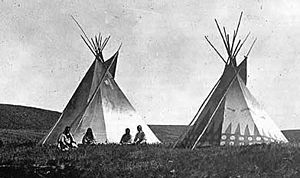
There were many Native American tribes of people in America long before the Europeans began colonizing it. The Kiowa and other plains tribes lived on the Great plains. The main Plains Indians tribes were the Dakota, the Blackfoot, the Cheyenne, the Lakota, and the Comanche. Wild game was abundant and included vast herds of buffalo (American bison). In the southwest, the Apache and Navajo inhabited the dry fruitful lands. The Plains Indians lived, traveled, and hunted from the Mississippi River to the Rocky Mountains, and from the north border of Mexico to halfway through Alberta.
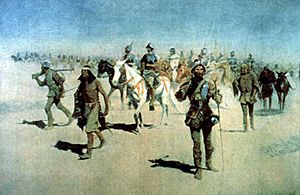
Francisco Vasquez de Coronado crossed the Arkansas River in 1541 and visited the central part of America. In 1776, the Juan Bautista de Anza Trail was used by Commander Anza and a group of almost 300 settlers, soldiers, and their families across the Sonoran and Colorado Deserts. They were in search of a better way of life along the edge of the Spanish Empire.
The Louisiana Purchase in 1803 expanded the western borders of America.
Early explorers and trappers
The Lewis and Clark expedition (1804–1806) was the first United States overland expedition across the western frontier, to the Pacific coast and then back, led by Captain Meriwether Lewis and Second Lieutenant William Clark.
Mike Fink, a river-boatman, was an early frontiersman that traveled into the Old West. He supposedly died around 1823 in the Rocky Mountains on a trip scouting, rafting, and trapping.
Trails, roads, and routes
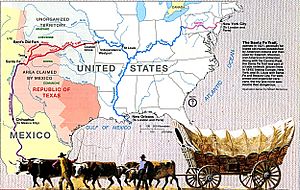
William Becknell opened the Santa Fe Trail ("Santa Fe Road") in 1821. The trail was used for commercial trade between Kansas City, Missouri, and Santa Fe, New Mexico, until 1880.
Bent's Fort, in Bent County, Colorado, was established on the Santa Fe Trail by William and Charles Bent, along with Ceran St. Vrain. It was the only major permanent white settlement on the Santa Fe Trail between Missouri and the Mexican settlements. Bent's fort was built in 1833 to trade with plains Indians and trappers. The main trade was with the Southern Cheyenne and Arapaho Indians for buffalo robes.
Emigrants travelling further on to California may have used the Old Spanish Trail. It was a trade route that began in Sante Fe, New Mexico, and ran in different directions through Colorado, Utah, and Arizona before reaching California.
The Southwest Trail was another pioneer route that was the primary route for American settlers traveling to Texas.
The Mormon Trail was the overland route the Mormon pioneers followed west from Nauvoo, Illinois, to Salt Lake Valley. They established Salt Lake City, Utah, in 1846.
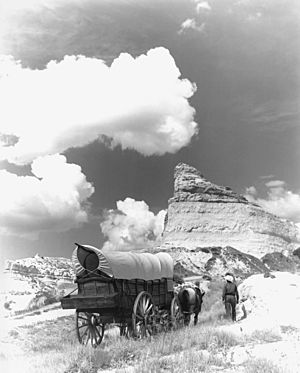
The Oregon Trail is perhaps the most famous trail that pioneers used to travel west in wagons. This trail helped the United States build a great nation across the North American continent. The Oregon Trail proceeded over 2,000 miles west through territories and land that later became six U.S. states (Missouri, Kansas, Nebraska, Wyoming, Idaho, and Oregon).
The California Trail shared a part of the Oregon Trail's route. It was another major overland emigrant route across the American West from Missouri to California in the mid-1800s. It was used by 250,000 farmers and gold-seekers to reach the California gold fields and farm homesteads beginning in the late 1840s.
Davy Crockett
Davy Crockett (nicknamed “King of the Wild Frontier”) was an American frontiersman, soldier, politician, and folk hero. He represented the state of Tennessee in the U.S. House of Representatives from 1827 to 1831 and again from 1833 to 1835. After being defeated in an election and being fed up with the eastern folks, he left for Texas in 1835.
On January 14, 1836, Crockett and 65 other men signed an oath to the Provisional Government of Texas and joined the Texas Revolution. Each man was promised about 4,605 acres (19 km²) of land as payment. On February 6, 1836, Crockett and about a dozen remaining men arrived at San Antonio de Bexar.
Crockett took part in the Battle of the Alamo (February 23 - March 6, 1836) and was assigned to defend the south palisade in front of the chapel. The Texas forces of 180-250 were overwhelmed by the 1,300-1,600 Mexican soldiers. Tradition has it that Crockett went down fighting inside the Alamo.
The Gold Rush and Civil War era
When stories spread of gold nuggets being discovered near Sacramento, California, people began mass-migrating across the old west into Northern California. It became known as the California Gold Rush. This period of mass hysteria lasted for about 10 years, with people rushing to California from 1848-1858. The most people traveled during 1849. They became known as the '49ers.
James Butler Hickok (nicknamed "Wild Bill") was a stagecoach driver on the Santa Fe route and Oregon Trail in 1855. His gun-fighting skills led to his nickname. He lived a while in Johnson County, Kansas, and later was a lawman. He became well-known for single-handedly capturing the McCanles gang.
The Pony Express Trail from St. Joseph, Missouri, to Sacramento, California, was also in use around this time. It was 1,840 miles in length. The Pony Express Trail traveled the states of Missouri and California and the Utah Territory, Nebraska Territory, and Kansas Territory lands. (The present day states include: Missouri, Kansas, Nebraska, Wyoming, Colorado, Utah, Nevada, and California.) It only stayed in operation for 18 months, between April 1860 and October 1861.
When the Civil War began in April of 1861, Kit Carson resigned his post as federal Indian agent for northern New Mexico and offered to help organize the New Mexico volunteer infantry. Carson participated in the Battle of Valverde (February 20–21, 1862), fought in and around the town of Valverde in the New Mexico Territory.
The Wild Wild West
While the Eastern United States was beginning to experience the Second Industrial Revolution (which started around 1871), the frontier was beginning to fill up. In the early days of the wild west, a lot of the land was in the public domain, open both to livestock raising as open range and to homesteading.
Throughout much of the Old West during this time, there was little to no local law enforcement, and the military had only concentrated presence in the area at specific locations. Buffalo hunters, railroad workers, drifters, and soldiers scrapped and fought. In the cities, business houses, dance halls, and saloons fed and sheltered those in the Texas cattle drive trade.
The historic Chisholm Trail was used for cattle drives. The trail ran for 800 miles from South Texas to Abilene, Kansas, and was used from 1867 to 1887 to drive cattle northward to the Kansas Pacific Railway, where they were shipped eastward. The trail was named after Jesse Chisholm, who had built a number of trading posts.
The cattle drivers had to watch for cattle rustlers (cattle thieves) along the trail. Both Americans and Mexicans were guilty of stealing cattle.
Dodge City
Fort Dodge, Kansas, was established in 1859 and opened in 1865 on the Santa Fe Trail near the present site of Dodge City, Kansas (which was established in June 1872). The fort offered some protection to wagon trains and the U.S. mail service. It also served as a supply base for troops engaged in the Indian Wars.
At the end of 1872, Dodge City became famous for lawlessness and gun-slinging. Law and order came riding into Dodge City with such respectable law officers as W. B. 'Bat' Masterson, Ed Masterson, Wyatt Earp, Bill Tilghman, H. B. 'Ham' Bell, and Charlie Bassett. The city passed a law that guns could not be worn or carried north of the "deadline" which was the railroad tracks. The south side, where "anything went," was wide open. Fort Dodge was closed in 1882, and due to a January 1886 blizzard, the cattle drives ended.
Wild Bill and Calamity Jane
After the American Civil War, Wild Bill Hickok became an army scout and a professional gambler. Hickok killed Whistler the Peacemaker with a long-range rifle shot, which helped keep the Sioux from uniting to fight against the settlers in the Black Hills.
In 1876, Calamity Jane settled in the area of Deadwood, South Dakota, in the Black Hills region, where she was close friends with Wild Bill Hickok and Charlie Utter, all having traveled in Utter's wagon train.
On August 2, 1876, Hickok could not find an empty seat in the corner where he always sat to protect himself from sneak attacks while he was playing poker. Instead, he sat at the poker table with his back to the door and was killed by Jack McCall.
In 1876, Calamity Jane nursed the victims of a smallpox epidemic in the Deadwood area. She married Clinton Burke in 1891 after the couple had been living together for several years.
Lincoln County War
The Lincoln County War (1877) was a conflict between two groups in the Old West. The "war" was between a group led by wealthy ranchers and another group led by the wealthy owners of the general store in Lincoln County, New Mexico.
Billy the Kid was one of the fighters on the side of the ranchers. He was famous at the time for being an outlaw and murderer.
Jesse James
The criminal Jesse James was infamous for his activities in the Old West. The media helped him become famous by writing stories about him and making him look like a Robin Hood of that day. James and his companions robbed their way across the Western frontier targeting banks, trains, stagecoaches, and stores from Iowa to Texas.
Even the Pinkerton National Detective Agency was not able to capture the gang, who took thousands of dollars. James is believed to have carried out the first daylight bank robbery in peacetime, stealing $60,000 from a bank in Liberty, Missouri.
Western Indian Wars
The Apache and Navajo Wars (1861–1886) had Col. Christopher "Kit" Carson fighting the Apache around the reservations in 1862. Skirmishes between the U.S. and Apaches continued until 1886, when Geronimo surrendered to U.S. forces.
Kit Carson used a scorched earth policy in the Navajo campaign, burning Navajo fields and homes, and stealing or killing their livestock.
He was aided by other Indian tribes, chiefly the Utes. He later fought with a combined force of Kiowa, Comanche, and Cheyenne at the First Battle of Adobe Walls. There was no clear winner, but Carson managed to destroy the Indian village and winter supplies.
Red Cloud's War (1866–1868) was led by the Lakota chief Makhpyia luta (Red Cloud) and was the most successful war against the U.S. during the Indian Wars.
By the Treaty of Fort Laramie (1868), the U.S. granted a large reservation to the Lakota. The land was to have no military presence or oversight and no American settlements. The U.S. government also promised to never build roads on the reservation. The reservation included the entire Black Hills.

Captain Jack was a chief of the Native American Modoc tribe of California and Oregon and was their leader during the Modoc War (1872–1873). With 53 Modoc warriors, Captain Jack held off 1000 soldiers of the U.S. Army for 7 months. Captain Jack killed Edward Canby, who was the only general killed during the Indian Wars.
The Black Hills War (1876–1877) involved the Lakota under Tatanka Iyotake (Sitting Bull) and Tasunka witko (Crazy Horse). The conflict began because the United States government was not honoring the Treaty of Fort Laramie (1868) and kept trying to take back the Black Hills from the Lakota people.
One its famous battles was the Battle of the Little Bighorn (1876). Sioux and Cheyenne, under the leadership of Tatanka Iyotake (Sitting Bull) and Tasunka Witko (Crazy Horse), defeated the 7th Cavalry that was led by George Armstrong Custer.
The end of the Indian Wars came at the Massacre of Wounded Knee (December 28, 1890) where Sitting Bull's half-brother, Big Foot, and some 200 Sioux were killed by the U.S. 7th Cavalry. (Only thirteen days before, Sitting Bull had been killed with his son Crow Foot in a gun battle with a group of Indian police that had been sent by the American government to arrest him.)
Gunfight at the O.K. Corral
The Gunfight at the O.K. Corral was an event of legendary proportion in the Wild West. The gunfight occurred on Wednesday morning, October 26, 1881, in a vacant lot, known as lot 2, in block 17, behind the corral, in Tombstone, Arizona.
Thirty shots were fired in thirty seconds. Wyatt Earp, Doc Holliday, Virgil Earp, and Morgan Earp fought against Billy Claiborne, Frank McLaury, Tom McLaury, Billy Clanton, and Ike Clanton. Both McLaurys were killed, as was Billy Clanton.
Buffalo Bill Wild West Show
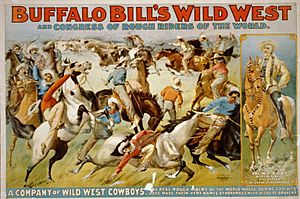
The frontiersman and showman William Frederick "Buffalo Bill" Cody toured the United States starring in plays based loosely on his Western adventures.
In Omaha, Nebraska, in 1883, Cody founded the "Buffalo Bill Wild West Show," a circus-like attraction that toured annually. Annie Oakley and Sitting Bull both appeared in the show.
In 1887, he performed in London in celebration of the Jubilee year of Queen Victoria. He toured Europe in 1889.
Fiction and non-fiction

Famous Old West locations and characters are shown in fictional movies and television shows like Gunsmoke and Bonanza.
For example, Dodge City, Kansas, the setting of Gunsmoke, was briefly a wide-open town, and Bat Masterson and Wyatt Earp were lawmen there. Marshall Matt Dillon and the other regular characters of Gunsmoke are fictional characters. Likewise, Virginia City, Nevada, was a real Old West mining town, but the Ponderosa Ranch and the Cartwright family of Bonanza are fictional.
Certain books and movies such as Butch Cassidy and the Sundance Kid, Shane, High Noon, and the novel The Virginian are other examples of stories from the "Wild West."
The American Old West has recently been made more popular in entertainment through the television series Deadwood.
Western movies
Westerns, by definition, are set in the American West, almost always in the 1800s. The western film genre usually tells stories of the conquest of the wilderness or the fighting over land rights (mostly the taking away of land from the people who lived on the land first). The genre has begun to become less popular as the U.S. moves further from the 1800s.
Tom Mix, Hopalong Cassidy, Gene Autry, and The Lone Ranger often filmed near Lone Pine, California, where since the early 1920s over 300 movies have been filmed.
John Ford was the first to film on location rather than in Hollywood. He packed up the crew and went out to Monument Valley to film movies like Stagecoach (1939).
Even when the story involves Apaches from New Mexico and Southern Arizona, Ford filmed it up in Monument Valley, far out of the Apache’s territory, because he liked the scenery.
In the late 1930s, filming started in Old Tucson, Arizona, site of now over 300 western movies.
A sub-genre of Western film, referred to as Spaghetti westerns, began in the mid-1960s. These movies were made with a lower budget and in a different area than the original westerns.
Interesting facts about the American Old West
- In 1799, a young boy found a large gold nugget while fishing on his property in North Carolina, 49 years before the California Gold Rush of 1848.
- In 1856, the U.S. Camel Corps suggested using camels as army pack animals in the Southwest. The U.S. Army said "no" to the proposal.
- The Maine outlaw Elmer McCurdy’s body traveled the U.S. in shows and carnivals from 1916 until 1977, when it was finally laid to rest in California.
- Acoma Pueblo in New Mexico is the oldest settlement in the United States, beating Jamestown by 457 years.
- Confederate forces of the Civil War fought at Fort Union, near Santa Fe, and were defeated by the Union army.
- Outlaws were photographed after they were killed for two reasons: to satisfy the public that the outlaw was actually dead and to be used as proof for collecting rewards.
- Despite what we see in the movies, African American cowboys made up about 25% of the cowboy population in the Old West.
- The first woman to rob a stagecoach without being killed was Pearl Hart. Because there was not a place for women in prisons, she was pardoned after eighteen months.
Images for kids
-
Daniel Boone escorting settlers through the Cumberland Gap
-
Siege of Fort Detroit during Pontiac's Rebellion in 1763
-
Map of the Wilderness Road by 1785.
-
Thomas Jefferson saw himself as a man of the frontier and a scientist; he was keenly interested in expanding and exploring the West.
-
Fur trading at Fort Nez Percés in 1841
-
Plate from Audubon's Birds of America
-
The first Fort Laramie as it looked before 1840. Painting from memory by Alfred Jacob Miller
-
Sam Houston accepting the surrender of Mexican general Santa Anna, 1836
-
General Kearny's annexation of New Mexico, August 15, 1846
-
Clipper ships took 5 months to sail the 17,000 miles (27,000 km) from New York City to San Francisco
-
400,000 men, women, and children traveled 2,000 miles (3,200 km) in wagon trains during a six-month journey on the Oregon Trail
-
The Handcart Pioneer Monument, by Torleif S. Knaphus, located on Temple Square in Salt Lake City, Utah
-
Map of Pony Express route
-
Settlers escaping the Dakota War of 1862
-
Camp Supply Stockade, February 1869
-
Homesteaders, c. 1866
-
Emigrants Crossing the Plains, 1872, shows settlers crossing the Great Plains. By F. O. C. Darley and engraved by H. B. Hall.
-
Sioux Chief Sitting Bull
-
Crow Chief Plenty Coups
-
Indian battles in the Trans Mississippi West (1860–1890)
-
"The Awakening" Suffragists were successful in the West; their torch awakens the women struggling in the North and South in this cartoon by Hy Mayer in Puck February 20, 1915
-
Temporary quarters for Volga Germans in central Kansas, 1875
-
A Buffalo Soldier. The nickname was given to the black soldiers by the Native tribes they controlled.
-
The Spanish mission of San Xavier del Bac, near Tucson, founded in 1700
-
A classic image of the American cowboy, as portrayed by C.M. Russell
-
1908 editorial cartoon of President Theodore Roosevelt features his cowboy persona and his crusading for conservation.
-
Wounded buffalo, by Alfred Jacob Miller
-
The Searchers, a 1956 film portraying racial conflict in the 1860s
See also
 In Spanish: Viejo Oeste para niños
In Spanish: Viejo Oeste para niños



